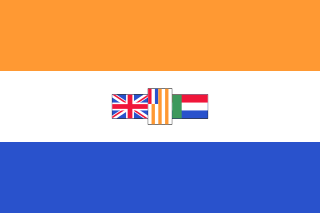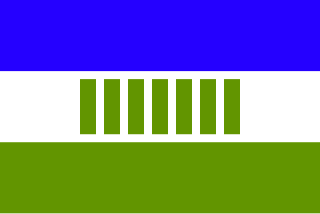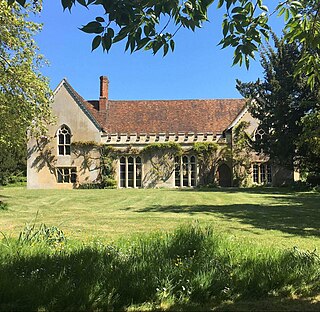
South West Africa was a territory under South African administration from 1915 to 1990, after which it became modern-day Namibia. It bordered Angola, Botswana, South Africa, and Zambia.
The history of Namibia has passed through several distinct stages from being colonised in the late nineteenth century to Namibia's independence on 21 March 1990.

A Bantustan was a territory that the National Party administration of South Africa set aside for black inhabitants of South Africa and South West Africa, as part of its policy of apartheid. By extension, outside South Africa the term refers to regions that lack any real legitimacy, consisting often of several unconnected enclaves, or which have emerged from national or international gerrymandering.

Kaokoland was an administrative unit and a bantustan in northern South West Africa. Established in 1980 during the apartheid era, it was intended to be a self-governing homeland of the Ovahimba, but an actual government was never established, and the territory was administered by the leaders of Hereroland. Like other homelands in South West Africa, the Kaokoland bantustan was abolished in May 1989, at the beginning of the transition of Namibia towards independence.

The Damara, plural Damaran are an ethnic group who make up 8.5% of Namibia's population. They speak the Khoekhoe language and the majority live in the northwestern regions of Namibia, however they are also found widely across the rest of the country.

Bushmanland was a bantustan in South West Africa, intended by the apartheid government to be a self-governing homeland for the San people.

Hereroland was a bantustan and later a non-geographic ethnic-based second-tier authority, the Representative Authority of the Hereros, in South West Africa, intended by the apartheid-era government to be a self-governing homeland for the Herero people.

Ovamboland, also referred to as Owamboland, was a Bantustan and later a non-geographic ethnic-based second-tier authority, the Representative Authority of the Ovambos, in South West Africa.

Tswanaland was a bantustan and then later a non-geographic ethnic-based second-tier authority, the Representative Authority of the Tswanas, in South West Africa, in the far central eastern area of the territory around the village of Aminuis. It was intended by the apartheid government to be a self-governing homeland for the Tswana people.

Kavangoland was a bantustan and then later a non-geographic ethnic-based second-tier authority, the Representative Authority of the Kavangos, in South West Africa, intended by the apartheid government to be a self-governing homeland for the Kavango people.

Rehoboth was a homeland and later, a second-tier authority, the Government of Rehoboth, in South West Africa intended by the apartheid-era government to be a self-governing homeland for the Baster people in the area around the town of Rehoboth, Namibia.

Namaland was a Bantustan and then later a non-geographic ethnic-based second-tier authority, the Representative Authority of the Namas, the in South West Africa, intended by the apartheid government to be a self-governing homeland for the Nama people. Namaland comprised an area of 2,156 km2 (832 sq mi) and was to accommodate the estimated 34,806 southern Namas of the South West African territory.

East Caprivi or Itenge was a bantustan and and later a non-geographic ethnic-based second-tier authority, the Representative Authority of the Caprivis in South West Africa, intended by the apartheid government to be a self-governing homeland for the Masubiya people.
Colin O'Brien Winter, was an English Anglican bishop, who served as Bishop of Damaraland, a diocese of the Church of the Province of Southern Africa coextensive with the territory of what is now Namibia during the apartheid era.

The Diocese of Namibia is part of the Anglican Church of Southern Africa, which is itself part of the Anglican Communion. The diocese, which covers the whole country of Namibia, was originally known as the Diocese of Damaraland. Most of the Anglicans in Namibia live in Ovamboland in the north of the country and speak the Oshikwanyama language.
The system of racial segregation and oppression in South Africa known as apartheid was implemented and enforced by many acts and other laws. This legislation served to institutionalize racial discrimination and the dominance by white people over people of other races. While the bulk of this legislation was enacted after the election of the National Party government in 1948, it was preceded by discriminatory legislation enacted under earlier British and Afrikaner governments. Apartheid is distinguished from segregation in other countries by the systematic way in which it was formalized in law.

The Turnhalle Constitutional Conference was a conference held in Windhoek between 1975 and 1977, tasked with the development of a constitution for a self-governed South West Africa (Namibia) under South African control. Sponsored by the South African government, the Turnhalle Conference laid the framework for the government of South West Africa from 1977 to independence in 1989.
Chief Frans Migub ǀGoagoseb is a Namibian politician and Damara leader. He is the party leader of the Namibian Democratic Movement for Change and was the party's candidate for president in the 2009 general election. In that election, ǀGoagoseb received 1,760 votes, placing eleventh out of twelve candidates for president. Only Attie Beukes of the Communist Party of Namibia received fewer votes than ǀGoagoseb.
The Damara Council was a political party in Damaraland, a Bantustan in South West Africa. In 1977 a breakaway faction joined the Democratic Turnhalle Alliance (DTA), while in 1989, the remainder of the DC was one of 8 political parties which formed the United Democratic Front. 6 of the 8 parties were ethnically affiliated, as they had taken part in the governments of various Bantustans. Since 1989, the UDF has maintained a presence in the National Assembly of Namibia, with Damara-speaking Namibians forming the core of the party.

The Namibia International Peace Centre was a non-governmental organization which was active between 1974 and 1981. It was based in The Abbey, Sutton Courtenay and later in Bethnal Green, East London. It was established by Bishop Colin Winter (1928–1981), an English Anglican bishop, who served as Bishop of Damaraland, a diocese of the Church of the Province of Southern Africa coextensive with the territory of what is now Namibia during the apartheid era. The Namibia International Peace Centre supported SWAPO.

















